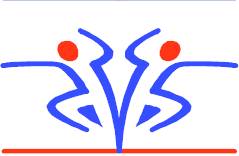
BEING
PHYSICALLY FIT

Want to do something that will help every
other aspect of a healthy lifestyle? Get yourself physically fit. There is no
substitute! Physical exercise provides health benefits that cannot be
obtained in any other way. It is central to almost all other aspects of a
healthy lifestyle. And you really don't need to suffer to do the sorts of
activities we're looking for. The greatest benefit to health is obtained by
changing from a "sedentary" lifestyle (more or less a "couch
potato") to doing 30 minutes of activity a day, such as walking, bicycling,
climbing steps, or working in the garden (not just riding a lawnmower, though).
AND . . . you don't have to do it all at once!
·
Want to lose
some weight? Exercise is one of the most important aspects of maintaining
weight.
·
Need to stop
smoking? Exercise makes it a lot easier, and increases the chances of
success.
·
Your blood
pressure, cholesterol or glucose levels are
elevated? Exercise helps control every one of these processes, perhaps to the
point that medications can be decreased or eliminated (under your physician's
supervision).
·
Even if you don't have any of
these health problems, exercise clearly will help your health. The simple act of
regular exercise can be shown to prolong your life.
·
Let's not forget about feeling
good! Just about all of us have been on an exercise program at one time or
another, and can attest that our bodies feel better, and we feel better about
ourselves.
·
And while we concentrate on heart
problems here at HeartPoint, exercise helps with so
many other health issues: Arthritis, osteoporosis, breast cancer, colon
cancer. . . .
Just as achieving a healthy weight doesn't
mean you need to look like a mode, achieving a healthy level of physical fitness
is not a matter of doing all of the things you see athletes to on TV or in
fitness magazines. This tends to be
discouraging and make it harder to achieve a much more satisfying goal:
a healthy fitness program. You
don't need to be an "athlete" to have a healthy level of activity.
And it's not just for the young -- exercise benefits the elderly more
than their younger counterparts. The
program just needs to be tailored to the appropriate fitness levels.
The fitness programs we'll talk about here are those designed to help
with your health . . . and there's a way for almost everyone to accomplish a
health-promoting exercise program that doesn't ask too much of a busy lifestyle.
You don't need expensive equipment, you don't need a personal trainer or to join
a health club (although we certainly would be glad if these things helped you
continue along a path of health!). You simply need to do 20-30 minutes of
moderate activity on most days of the week. This may be as simple as walking
at a brisk pace.
Go out and start making a healthier and more
enjoyable life . . . and exercise for health!
LINKS TO THE
REST OF
THIS SECTION
Some
common sense reminders.
What are the benefits?
Think about this . . . exercise is as
important as high cholesterol or high blood pressure.
Before you start . . . let's get warmed up.
How much exercise should I do?
What sorts of exercise should I do?
What about weights
and body building?
What are the risks?
Do I need to talk to my doctor before starting?
What is "aerobic fitness" as opposed to "cardiovascular
fitness"?
I travel a lot what should I do?
I just had a heart attack or bypass surgery. What should I do?
How do I tell when I am doing too much?
What about when it's hot?
What about when it's cold?
How do I take my pulse?
But I have a lot of joint problems, and they get worse when I exercise. What
should I do?
I get very short of breath or have other symptoms when I exercise. What should I
do?
I'm afraid my blood pressure will get too high when I exercise.
I'm pretty old. I don't need to exercise anymore, right?
What about health clubs and personal trainers?
What is a good program to start with?
I
want to take it to a higher level. What should I do?
How come exercise does so much good for the arteries?
How many calories will I burn?
Some other resources and links.
Keep
an exercise diary.
The Big Points.
HeartPoint's Exercise
Planner.
Some
common sense reminders.
We will say more about these issues below,
but remember that you should
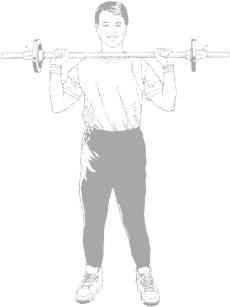 Warm
up.
Warm
up. We won't spend a lot of time here. Almost
everyone has heard these facts before. But as a quick reminder more motivating
yourself, don't forget the amazing number of things that activity does for you:
Think about this . . . exercise is as
important as high cholesterol or high blood pressure.
One of my favorite studies is of a group of
men in Hawaii. This was not a very
selected group, just men who were retired and who did not smoke.
The men who did little or no activity had an increased mortality rate
twice that of men who walked 2 or more miles daily.
40% of the non-exercisers died over 12 years as compared to 20% in the
exercise group. (NEJM 1998;338:94).
Other studies have shown (JAMA 1989;262:2395
and NEJM 1988;319:1379 among many others) that exercise may be more important
than the things many people worry about (like high blood pressure and high
cholesterol), and for which billions of dollars are spent in this country trying
to control. Men in the Aerobics
Center Longitudinal Study who were at high risk because of their high blood
pressure or high cholesterol but were also physically fit had lower death rates
than those who would otherwise be considered low risk but were not physically
fit. For example, highly fit men
with blood pressures greater than 140 had a death rate of 24 per 10,000
patient-years (the number of patients observed multiplied by the number of years
they were observed), while those whose blood pressure was less than 120 but were
not physically fit had death rates of 60 per 10,000 patient-years.
Those who did not have high blood pressure or high cholesterol but were
not physically fit were 2.5 times more likely to die than those who had higher
risk blood pressure or cholesterol but were physically fit.
Before
you start . . . let's get warmed up. And don't forget to cool down.
You should "warm up" and "cool down" for about 5 minutes before and after your exercise. If the exercise is walking or jogging, walk slowly as a warm up. Stretching is an excellent way to warm up and cool down.
How
much exercise should I do?
This is really a key question. And the two
most correct answers are:
1. In general, the more the better.
2. But some is way better than none!
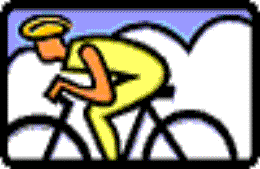 Just
like everything else, it depends on what you're looking for:
Just
like everything else, it depends on what you're looking for:
The key here is to DO SOME EXERCISE
REGULARLY. If you can't do 30 minutes today, do 10 minutes of walking. Continue
to work this most healthy of pursuits into your life.
Check out our Planner to help come up with the best program for you.
What
sorts of exercise should I do?
 Design
and follow a program you enjoy. That
will help keeping you do it, and actually will help you achieve all of the
benefits of exercise.
Design
and follow a program you enjoy. That
will help keeping you do it, and actually will help you achieve all of the
benefits of exercise.
There are many enjoyable activities to
participate in. Most experts recommend the simple act of walking. Virtually
everyone knows how to do it, it is readily available, it is
"portable", it is inexpensive, and it works. You can do it alone, with
a friend or with a group. It generally has a low risk of injury.
Jogging certainly is an acceptable form of
exercise. Interestingly though, you burn just as many calories walking a mile as
you do jogging a mile. You could obviously jog further in the same amount of
time and therefore burn more calories and obtain a greater degree of fitness.
Jogging generally extracts a little greater price in terms of aches and pains in
your bones and joints than walking does.
Some people find that working out with a
friend or an entire group is more fun than isolated activities. It can indeed be
more enjoyable. It can help encourage regular participation. You and a friend at
home or at work can do a walking program together. There are a host of
activities at health clubs from aerobic dance, to swimming, to water aerobics .
. . the list is virtually endless. These groups are often supervised as well.
Some people enjoy competitive sports such as
handball or racquetball or tennis. Others enjoy weight lifting. Do you like to
ski? How about mowing the lawn?
Check out our Planner to help come up with the best program for you.
What
about weights and body building?
Walking and jogging have
been the traditional means recommended as exercise for “fitness”.
These activities are
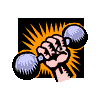 “aerobic”,
increasing the body’s use of oxygen, and appear to be the best way to improve
cardiovascular health. Weights and
body building, which are more focused on increasing the strength of the muscles,
have not been felt to be as important, and in some cases felt to be dangerous.
The straining associated with weight lifting can increase the risk of
myocardial infarction. Long term
and fairly intense weight training can cause thickening of the heart muscle,
which increases the need for blood flow through the coronary arteries which may
be a problem in those with blockages in those vessels.
“aerobic”,
increasing the body’s use of oxygen, and appear to be the best way to improve
cardiovascular health. Weights and
body building, which are more focused on increasing the strength of the muscles,
have not been felt to be as important, and in some cases felt to be dangerous.
The straining associated with weight lifting can increase the risk of
myocardial infarction. Long term
and fairly intense weight training can cause thickening of the heart muscle,
which increases the need for blood flow through the coronary arteries which may
be a problem in those with blockages in those vessels.
However, thinking about
this has recently changed to some degree. Heavy
weight training is still not a recommended prescription for people with heart
disease (and the use of steroids,
creatine, and other such substances are to be avoided!).
The use of appropriate “resistance training” is now encouraged.
A recent American Heart Association Advisory
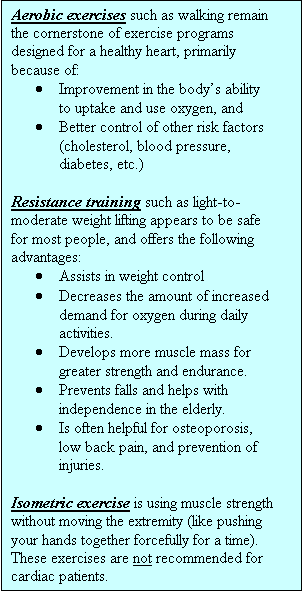 (Circulation
2000;101:828) stated:
(Circulation
2000;101:828) stated:
“Although
exercise programs have traditionally emphasized dynamic lower-extremity
exercise, research increasingly suggests that complementary resistance training,
when appropriately prescribed and supervised, has favorable effects on muscular
strength and endurance, cardiovascular function, metabolism, coronary risk
factors, and psychosocial well-being.”
Resistance training has been studied and is recommended for those
without cardiac disease, and can be safely carried out in those with mild heart
disease. There is not sufficient
information available to recommend it for those with moderate-to-severe heart
problems.
For those without heart disease:
·
A workout lasting 20-30
minutes should be accomplished at least twice, and preferably three times per
week.
·
The workout generally
consists of 8-10 exercises.
·
Early sessions should
use relatively low weights to allow for adaptation to the increased load, and
practice good technique.
·
“Good technique”
includes slow controlled movements, full relaxed inspiration and expiration, and
avoidance of breath holding.
·
When one is comfortable
using a given weight for 12-15 repetitions, then the weight can be increased by
5%.
If
you have bone or joint problems, consult with the physician who cares for you
before beginning, since repetitive exercises may increase wear and tear on
particular areas of the body. Some
physical therapists and personal trainers may be able to help as well.
There is generally a program that can be devised that will help, however.
There are a few. Much is made of the rare
occurrence of sudden death of someone who is exercising. This certainly may
occur. People who have or are at significant risk of heart disease do need to
check things out with a physician prior to starting an exercise program to
minimize this risk. On balance however, exercise clearly lowers the overall risk
of death, and rather dramatically reduces the risk of sudden death.
Exercise may also be associated with
injuries to bones and joints, and these do need to be tended to when they occur.
Accidents occur. "Overuse" and "repetitive strain" refer to
injuries that may occur from doing the same motions or activities over and over.
On the other hand, doing too many different activities all of the time may not
allow one to really adapt and prevent injuries from fewer activities.
Starting slowly, stretching and warming up
are important preventative measures. Ignore the popular expression "No
pain, no gain". Pay attention to pain, and don't push it until you
thoroughly understand what your body is trying to tell you. Prompt attention to
problems can lead to solutions that allow you to continue to exercise enjoyably.
Many injuries may be helped by practitioners familiar with sports injuries.
Do
I need to talk to my doctor before starting?
Certainly, if you've recently had a heart
attack or bypass surgery, you will need to know your specific limits (see
above).
Many authorities recommend that you be
evaluated by a physician before starting an exercise program if you fall into
certain groups:
What
is "aerobic fitness" as opposed to "cardiovascular fitness"?
There are different types of fitness. Good
athletes achieve "aerobic fitness", giving them the ability to sustain
significant activities for a long period of time. To achieve this, one needs to
exercise at least four time a week for 15-30 minutes, employing an exercise
which will raise their heart rates to 60-80% of their age predicted maximum
heart rate. If you're interested, a good approximation of your maximum heart
rate is 220 minus your age.

"Cardiovascular fitness" is good
for the health of your heart and the rest of your body. To do this, exercise
15-30 minutes four times a week without worrying about your heart rate.
I
travel a lot. What should I do?
Traveling makes it hard to follow a heart
healthy lifestyle in many ways. Diet and sleep are difficult to follow. But
exercise programs can definitely be continued. You can walk while you're waiting
for a plane, or walk in place in your hotel. Most hotels provide exercise
equipment. People who advise on good travel habits note that an exercise program
cuts down on jet lag. Keep with it!
I
just had a heart attack or bypass surgery. What should I do?
You should definitely start a program, and
it should be according to instructions from your physician. Many hospitals offer
"Cardiac Rehabilitation" programs specifically designed for people
with these conditions. They are supervised, most often by specially trained
nurses, and provide a structured setting to exercise in a safe manner. These
programs are also of valuable in providing more information on heart disease and
a heart-healthy lifestyle. People with similar heart conditions are also
enrolled, providing a great deal of emotional support.
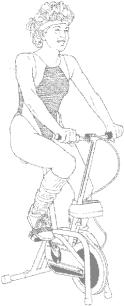 General
guidelines that are usually offered in this setting include:
General
guidelines that are usually offered in this setting include:
How
do I tell when I'm doing too much?
First of all, pay attention to how you feel.
If you are having chest pain, or dizziness, or marked fatigue or shortness of
breath . . . stop. You should check things out if you develop an irregular pulse
or become nauseated. If in doubt about these or other symptoms, go ahead and
stop the exercise for now and discuss it with your doctor.
It is also useful to monitor your pulse to
give an assessment of how hard you are working. A person's pulse is affected by
a variety of factors, most particularly some underlying heart problems, certain
medications and a person's age. It is useful to consider a "target heart
rate".
You can very definitely have problems from
getting overheated. "Heat exhaustion" is characterized by dizziness,
headache, nausea and sometimes confusion. "Heat stroke" is more
serious yet. It too is accompanied by dizziness,
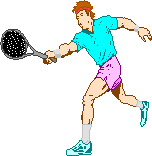 headache
and nausea but is notable by two other problems: sweating stops, and body
temperature becomes dangerously high.
headache
and nausea but is notable by two other problems: sweating stops, and body
temperature becomes dangerously high.
Blood vessels clamp down in response to cold
weather. You are able to do more without the warning sensation of overheating,
and in fact you may feel better. But your heart is working harder due to the
clamping down of the blood vessels.
You don't have to stop because of the cold
weather, though! Again you can certainly move indoors . . . walk on a treadmill
or in the mall. Or go to a health club.
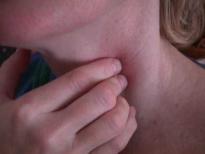 You
can take your pulse either at the wrist (the radial artery) or the neck (the
carotid pulse). It is important to relax your hand and wait a
You
can take your pulse either at the wrist (the radial artery) or the neck (the
carotid pulse). It is important to relax your hand and wait a
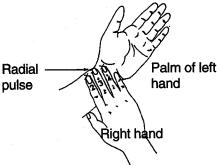 few
seconds to allow the pulse to "come to you".
few
seconds to allow the pulse to "come to you".
For the radial pulse, place your second,
third and fourth fingers along the wrist on the same side as the thumb and place
gentle pressure. Relax the fingers, and give yourself 5-10 seconds to begin to
appreciate the pulse. For the carotid, use these same fingers placing them to
the side of the larynx (Adam's apple). You may also use your thumb if it is
more.
It is generally easiest to take your pulse
for 15 seconds and multiply it times four.
But
I have a lot of joint problems, and they get worse when I exercise. What should
I do?
You should start slowly. See the physician
who usually cares for your joint problems, or consider seeing a sports medicine
specialist.
Good general rules to follow include:
·
Select "low impact"
activities (stationary bike, rowing, swimming, water aerobics).
Activities such as yoga or t'ai chi chi may be very beneficial.
·
Select shoes that minimize
impact.
·
Avoid stair climbing, jogging,
and running in people who have arthritic conditions involving the hip and / or
knee.
·
Include stretching an joint
mobility as key exercise components.
·
Use low intensity and low
duration initially, increasing gradually.
·
Set "time goals"
instead of distance goals.
·
Avoid activities that cause
increased joint pain lasting more than an hour or two after exercise.
·
It may help to apply warmth to
affected joints before starting.
I
get very short of breath or have other symptoms when I exercise. What should I
do?
You should definitely check with your doctor
before starting an exercise program
I'm
afraid my blood pressure will get too high when I exercise.
Blood pressure normally increases
during exercise, often to the range of 200 mm Hg or higher. A moderate rise in
blood pressure is to be anticipated, and need not be any cause for alarm. If you
have substantial medical problems, you may wish to begin a supervised program,
such as are available with local Cardiac Rehabilitation programs.
Exercise lowers blood pressure in the long run.
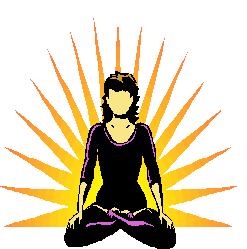 I'm
pretty old. I can't do all of those exercises.
I'm
pretty old. I can't do all of those exercises.
You may not be able to do all of the
exercise you were able to when you were younger, but you can definitely do
enough to really benefit your health. It is my personal observation that the
more activity a senior is able to do, and the more activity he or she does, the
better their longevity. It makes a tremendous impact on their sense of
well-being as well.
Repetitive strain injuries may be more
common, and care should be taken in designing the program prescribed. Extra care
should be taken in choosing exercise clothing and equipment, and injuries should
be tended to promptly before aggravating them with more inappropriate exercises.
An exercise facility or health club may be more valuable for people in this age
group.
However, every attempt should be made to
design and stick to an exercise program . . . the older, the better.
What
about health clubs and personal trainers?
If you can afford these luxuries, they may
be very worthwhile. They generally offer special equipment, and reputable
establishments have some special expertise in these areas. Many feel more
motivated to follow a program when they have a financial commitment. Some people
find that a scheduled time makes continued participation more likely. Health
clubs also offer group exercise programs, which are attractive to many people.
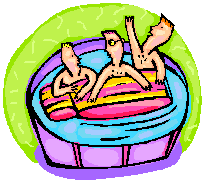
If you find that this offers you some
advantage, you should participate. However, don't feel that you "have
to" get involved in such a program. You can have a successful fitness
program without this.
What's
a good program to start with?
Start slowly. By doing this, you'll lower
the risk of injury, and be more able to gradually integrate it into your
lifestyle.
Pick one or more activities that you can do
all year long. There are a lot of activities that you can do that involve
exercise, but not all of them really lend themselves to a regular form of
exercise. Canoeing is great, but not practical as a 3-4 time per week exercise
for most people.
Just like with dieting, set reasonable
goals. It is marvelous to watch some of today's athletes. You do not need to be
as fit or beautiful as they are . . . aim for a level which will help your
health.
If you're just starting out, start out your walking
program by "strolling" (20-24 minutes per mile or 2.6-3 miles per
hour). Pick it up to a "brisk" walk (about 15 minutes per mile or 4
miles an hour). "Aerobic walking" is pretty quick, around 5
miles per hour. Jogging is going faster than this. Roller skating
is similar (wear a helmet and safety guards on knees, elbows and wrists!). Ice
skating is likewise suitable. Jumping rope may be enjoyable as well,
although it may also be tough on the ankles.
Bicycling
is very enjoyable to many people (and my personal favorite). It is relatively
easy on the joints, and can be a good means of transportation. It's enjoyable to
do with others. On the other hand, it is pretty weather dependent. Wear a
helmet! Stationary bicycles avoid these weather problems, but are among
the least exciting activities of all. This can be spiced up by reading or
watching TV or movies.
Swimming
is an ideal exercise . . . as long as you have the facilities. It uses all of
the major large muscle groups, achieving a large amount of energy expenditure,
without putting much strain on the body. You need access to an indoor pool as
well as time to change, swim and change back. It should be encouraged as a part
of a fitness program if at all possible. There are programs of water aerobics
which are ideal for those who have joint problems or find other forms of
exercise too tough on their joints.
Aerobic dancing,
or any dancing for that matter, is an enjoyable and sociable form of
recreational exercise. Aerobic dancing can put some strain on the joints,
although it is generally not severe.
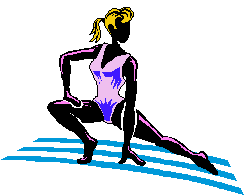
Sports such
as basketball, volleyball, tennis, table tennis, racquetball, etc. are
good forms of exercise, and many people enjoy the speed, challenge and
competition. They are tough on the joints in many cases if done with any
intensity. They are classic traps for "weekend warriors" to injure
themselves. My own personal view is that most people over the age of 35 may be
asking for trouble with competitive activities, particularly if they are the
type that take a great deal of pleasure from being able to "suck it
up" when they're tired so they can win the match. This invites trouble.
Pursue these activities, and they are indeed very enjoyable, but realize that
they should not turn into literal "life and death" situations.
By the way, if you golf, you only get to
count the time you're walking . . . and realize this should be a brisk walk and
not a stroll. Please don't even ask about riding a cart!
I
want to take it to a higher level. What should I do?
Let's look at some levels of fitness (these
are described in the site "Shape Up America" at www.shapeup.org ):
How
come exercise does so much good for the arteries?
It makes plenty of sense that exercise
prevents injuries, promotes strength and weight loss, and cuts down on problems
like osteoporosis. It is not
immediately clear why it will help prevent problems related to clogged arteries.
It had been speculated in the past that it helped by promoting weight
loss, decreasing cholesterol, and other secondary factors.
However, recent studies have shown whole new ways that exercise cuts down
on atherosclerosis and cancers.
There is plenty of evidence that not only do
cholesterol levels fall, but that "good"
HDL levels rise with exercise. Likewise,
there is abundant evidence that there is a decreased tendency toward blood
clotting. Studies have shown a decrease in the inflammatory activities
of some of the white blood cells in the blood which have been shown to be
instrumental in promoting the progression of blockages in arteries (JAMA
1999;281:1722). Aerobic exercise
has proven to decrease the conversion of "bad" LDL cholesterol to the
"really, really bad" oxidized LDL (Arterioscler Thromb Vasc Biol
1998;18:1181). It has also been
shown to improve the ability of the coronary arteries to dilate in response to
stress, a basic function of healthy arteries lost in those with atherosclerosis
(NEJM 2000;342:454). These are
fairly complex concepts, but the point is clear:
Exercise has fundamental health promoting activities that cannot be
duplicated by any other mechanism. Most
people would feel cheated if they weren't given the chance to take a lifesaving
medicine . . . they should not miss the opportunity to do this for their health.
How
many calories will I burn?
To be honest, exercise alone is not a great
way to lose weight -- you have to cut down on the number of calories taken in as
well. Nevertheless, it may be
interesting to see how different activities stack up in this area.
Here are some estimates of the number of calories burned by a 150 pound
person (heavier people will burn somewhat more, lighter people somewhat less):
|
Walking 2 mph Walking 3 mph Walking 4.5 mph |
240
cals 320
cals 440 cals |
|
Bicycling 6 mph Bicycling 12 mph |
240
cals 410 cals |
|
Jogging 5.5 mph Jogging 7 mph |
740
cals 920 cals |
|
Running in place Running 10 mph |
650
cals 1280 cals |
|
Swimming 25 yards/min Swimming 50 yards/min |
275
cals 500 cals |
|
Jumping rope |
750 cals |
|
Tennis (singles) |
400 cals |
|
Cross-country skiing |
700 cals |
|
Mowing the lawn |
500 cals |
|
Shoveling snow |
550 cals |
|
Passionate sex |
450 cals |
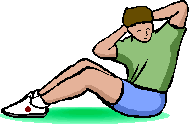
|
American Heart Association |
YMCA of the USA |
Nat'l Org of Mall Walkers |
|
Am Council on Exercise |
YWCA of the USA |
Am Running & Fitness Assoc. |
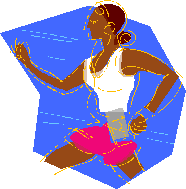
It's not a requirement, but it can be a help to plot your progress, particularly if you've recently had a heart attack or bypass. Take a look at Heartpoint's exercise diary.
A healthy lifestyle definitely
includes being physically fit. Activity and exercise provide unique additions to
a healthy lifestyle. Regardless of anything else, modest amounts of exercise
will clearly help you live longer -- a "sedentary" lifestyle is an
independent "risk factor" for developing blocked arteries or
experiencing sudden death. It helps decrease the risk of other diseases
including certain cancers, and clearly leads to improved psychological
well-being. Additionally, exercise will help with lowering the risk from other
health problems such as high blood pressure, diabetes, high cholesterol and
being overweight. There is probably not another single thing that you can do
that will benefit your health more.
Fortunately, you do not have to do enormous
amounts of activity to realize great benefits for your health. We are not
talking major workouts, just increasing the amount of activity you do during the
day to a total of 15-30 minutes daily. You can get some of this by parking a
long way from the front door of the store where you're going shopping, or maybe
getting off the elevator one floor early and taking the stairs. The rest of the
work does not need to involve a great deal of trouble or money -- walking at a
brisk pace will do just fine.
People who are not fit, are older, or who
have problems with their heart should check with their physician before
beginning. Common sense ideas such as warming up, starting slow and gradually
increasing the level of activity, and doing some simple things to avoid injury
are certainly good ideas.
Remember, there are no substitutes! You
don't have to be an athlete! Set some reasonable goals. Commit and stick with
this miraculous health-promoting activity.
©COPY;1997 HeartPoint Updated May 1,2000.
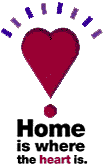
![]()
| Commentary |
Food You Will Love | HeartPoint
Gallery | In The News | Health Tips | What's New
|
| Information Center | Home
|
This site presents material for your information, education and entertainment. We can assume no liability for inaccuracies, errors, or omissions. Above all, material on this site should not take the place of the care you receive from a personal physician. It is simply designed to help in the understanding of the heart and heart disease, and not as a diagnostic or therapeutic aid. You should seek prompt medical care for any specific health issues. Please feel free to browse the site and download material for personal and non-commercial use. You may not however distribute, modify, transmit or reuse any of these materials for public or commercial use. You should assume that all contents of the site are copyrighted. ©COPY;1997 HeartPoint